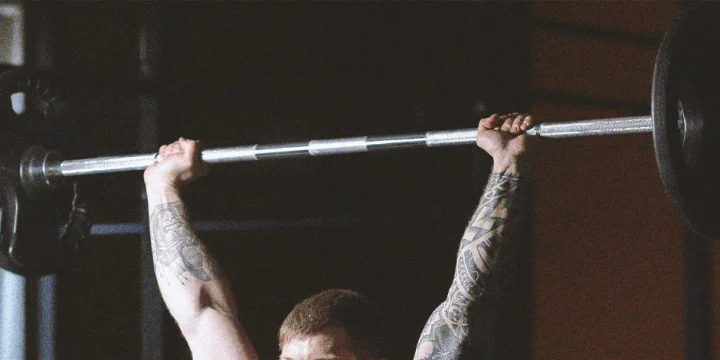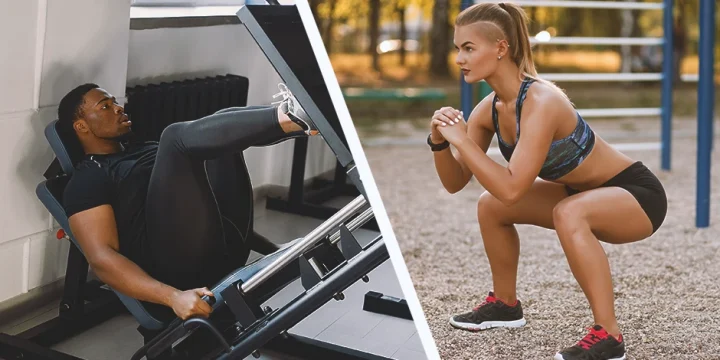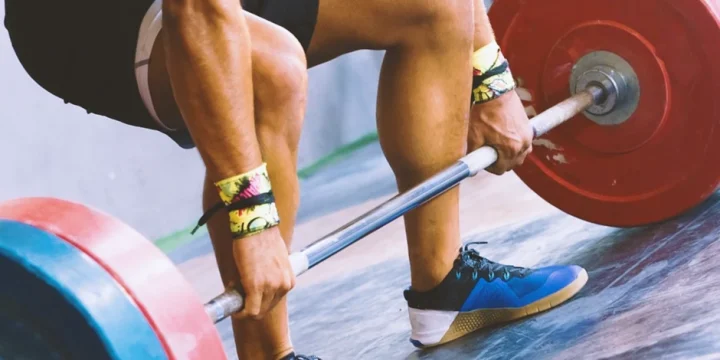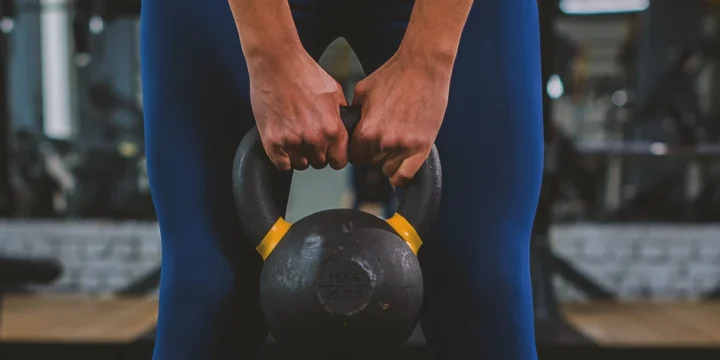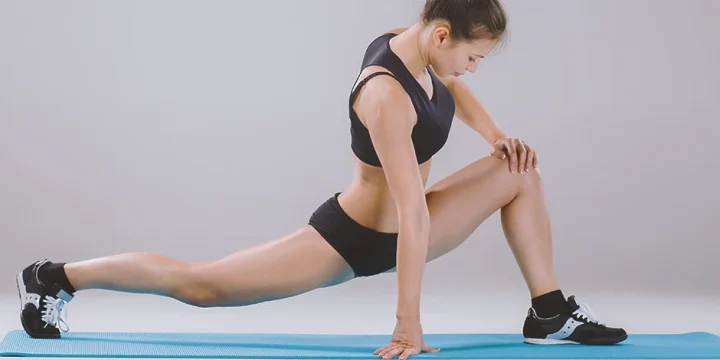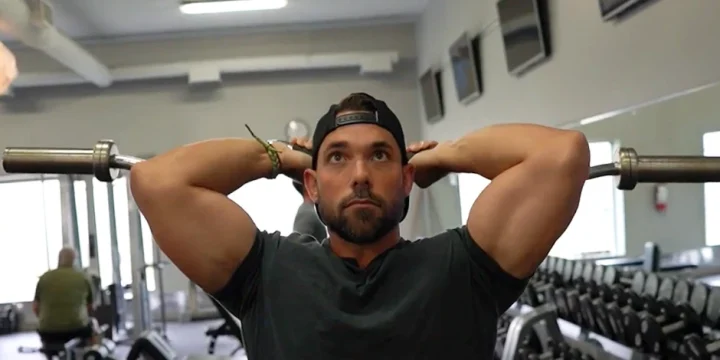Many bodybuilders will shun the leg press machine because they are entirely loyal to the squat bar.
But as a coach, I make sure that all my clients get used to doing a few different leg exercises with different equipment.
My research and work with athletes of all fitness levels have shown that you can significantly impact the shape of leg muscles by simply adjusting the leg press foot placement.
And getting used to those changes in foot placement is a lot easier on a leg press machine.
Quick Summary
- The five best leg press foot placement positions include Regular Stance, Narrow Stance, Wide Stance, Low Placement, and High Placement.
- Leg press workouts primarily target the quadriceps, hamstrings, glutes, and calf muscles, providing a well-rounded lower body exercise.
- According to studies published in PubMed, focusing on the quads with the regular stance is effective; however, incomplete hip joint extension may limit full tension in the glutes.
- In my opinion, adjusting foot placement during leg press exercises can truly transform your leg workout, maximizing muscle engagement and overall effectiveness.
5 Leg Press Foot Placement Positions
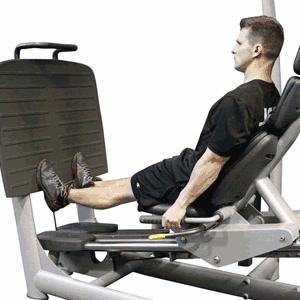
From my coaching experience, when it comes to leg press exercises, it's essential to understand that there are various machine variations available.
These options include horizontal, vertical, or angled leg press machines, each with its unique advantages. Depending on your fitness level and goals, you may find that one type of machine is better suited to your needs than another.
The typical angle of a leg press machine is about 45 degrees, and because the machine itself provides a lot of stability, it makes adjusting the foot placement easier and safer than during squats.
Here are five leg press foot placements and what they will help you achieve.
1. Regular Stance
This is where you should generally get started with your routine, and it involves getting into a foot position about shoulder-width apart.
Here are the steps involved.
- Step 1: Get into the starting position with your feet in the center of the platform and make sure they are shoulder-width apart by pointing your arms straight down to your ankles.
- Step 2: Keep your toes pointing slightly to the outside to provide more stability and control.
- Step 3: Adjust the seat position so that you can go as deep as possible as a maximum range of motion will deliver better results than higher weight loads, according to the SAGE Open Medicine [1].
- Step 4: You should feel most of the strain in your quads, but this foot placement should also target the glutes and hamstrings.
Overall, this is a great way to target the quads specifically, but studies published in PubMed have shown that when hip joints are not fully extended, then the glutes don't get to full tension [2].
2. Narrow Stance
This is one of my favorite leg press foot placements, and many of my clients choose it because a narrow stance like this isn't the safest thing to do with a squat bar on your shoulders.
When you're freestanding for a squat, you'll need the stability of a wide stance to avoid making a fool of yourself.
- Step 1: Step into the leg press and place your feet in the center of the plate about hip-width apart. If you look down one leg, your toes should be in line with your hip and knee. I would recommend keeping your toes neutral and pointing forward.
- Step 2: Adjust the machine to make sure you end up bending your knees as much as possible but keep in mind that this stance will result in your thighs making contact with your core and limiting your range.
- Step 3: Make this a slow movement as you bend your knees and slightly faster as you straighten them out again. The hip-width stance will specifically target the outer thigh muscles, but you should also feel it in your core.
3. Wide Stance
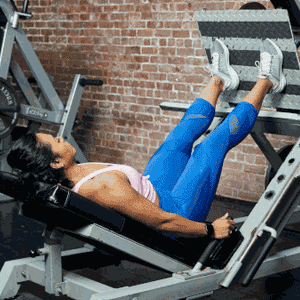
The wide stance leg press is my second favorite, but I'll say right here that it may require more hip flexion.
That means more flexibility and range of motion in the hip joints.
If you do feel pain with this stance, then try to gradually build up strength to support the mobility of the hip flexors [3].
- Step 1: Start with a wider foot placement than what you do for the regular ones above. That means that your feet should be centered on the plate and about 1.5 times your shoulder-width apart.
- Step 2: Flare out your toes to make sure that you don't add too much strain on your ankles.
- Step 3: Start off with a bit less range of motion as the wide stance may add more strain to the hip joints. And if you don't have much hip flexibility, going down too low could become sore.
- Step 4: Keeping your feet wide may help to target the inner thigh muscles, and you'll also find that there's more strain on the glutes as well.
4. Low Placement
Low foot placement refers to positioning your feet on the footplate. This is something that is pretty much impossible to do with a regular squat.
- Step 1: As you look at the platform, get your heels as close to the bottom edge as possible. This will put your upper body slightly forward during the leg presses.
- Step 2: Keep a shoulder-wide stance and your toes slightly outward for support.
- Step 3: Aim to go down as deep as possible, which might mean taking a slightly lower weight load.
- Step 4: You'll feel this a lot more in your quads and calves, and your core should be engaging quite a lot. If you can get your knees further in front of your toes, you'll add more strain to the calves as well.
5. High Placement
Finally, we get to the high foot placement, and it's often a good one to finish up your routine. I personally find it's a bit less strain on the hips allowing you to take a few easier reps.
- Step 1: Set yourself up in the leg press machine with your toes close to the top edge of the platform. This might feel a bit strange at first, but you'll notice the difference it makes once you get started.
- Step 2: Aim to keep your toes in a neutral position, and the feet should be shoulder-wide apart.
- Step 3: Same as with the low placement above, aim to go as deep as possible.
- Step 4: You will predominantly feel the pressure on your glutes and hamstring muscle group and ensure that your entire back touches the backrest throughout the leg presses.
Also Read: Fast Feet Exercises To Improve Foot Speed
Does Your Foot Position Matter On A Leg Press Machine?

Based on my experience, foot position is crucial during leg presses, offering advantages over regular squats. Unlike squats, where stance adjustment is limited for safety reasons, the leg press machine provides stability and allows for varied foot placement.
This variation increases strain on your quads, glutes, hamstrings, calves, and engages your core. Keep in mind that there's no one-size-fits-all best foot placement; regularly changing positions during sets helps achieve balanced leg and buttock development.
To fully appreciate the benefits of the leg press, it's crucial to grasp the muscles involved in this compound movement. The leg press primarily targets the quadriceps, hamstrings, glutes, and calf muscles. By understanding which muscles are engaged, you can tailor your foot placement to emphasize specific muscle groups during your workouts.
"While it may not train all the stabilizing muscles in your joints or recruit the core muscles in the same manner that free weights exercises do, working in a fixed movement pattern with a resistance machine can be very useful for isolating the exact muscle you're looking to train."
- Joel Snape, Writer at coachmag.co.uk
Foot Placement For Leg Press Calf Raises

I like to get my clients to do calf raises in a leg press machine. It suits many people that don't like holding heavy barbells or resting one on the shoulders.
And by adjusting your foot placement, you can better sculpt your lower legs [4].
Wide Angle
This is where you keep your toes pointing out during the calf raises. You should also place your feet lower on the platform for more focus on the calves.
The result is more strain on the inner calf muscle.
Neutral Angle
Sticking with leg press foot placements, you'll still want your feet to be lower on the platform.
The effect of this toe angle is an even strain across the calf muscles.
Narrow Angle
This is where your toes point inwards, and it may require a bit more ankle mobility. For that reason, try this with a lower weight first.
The effect is more muscle building on the outer calf muscles.
Related Articles:
FAQs
Does the Leg Press Work Your Whole Leg?
Yes, the leg press can work your whole, but it depends on how you place your feet. With minor adjustments, you can put more strain on your quads, calves, hamstrings, and glutes.
How Deep Should You Go On a Leg Press?
You should aim to go as deep as possible on a leg press. The reason is that extending your range of motion should add more strain to the muscles, and it gives you more scope to increase the leg press weight load over time.
References:
- https://www.ncbi.nlm.nih.gov/pmc/articles/PMC6977096/
- https://pubmed.ncbi.nlm.nih.gov/11767248/
- https://www.everydayhealth.com/hip-pain/understanding-hip-flexor-pain.aspx
- https://themusclephd.com/quick-tips/toe-angle-and-calf-raises/
About The Author
You May Also Like
